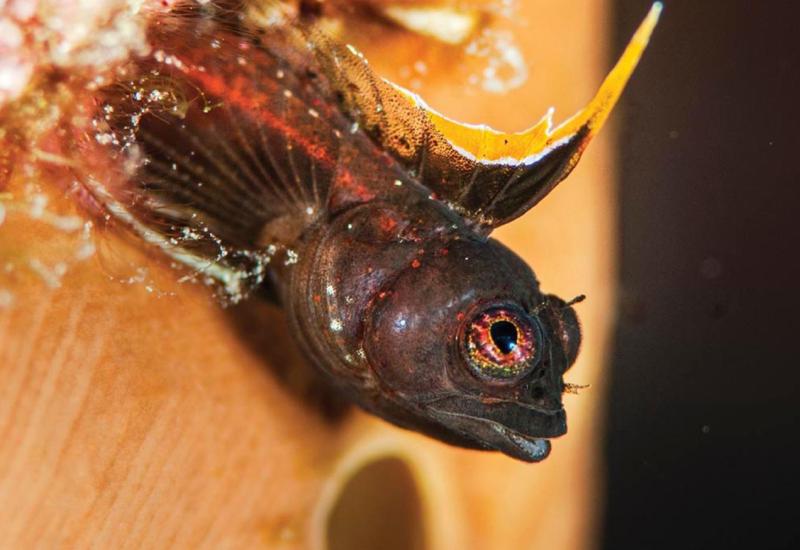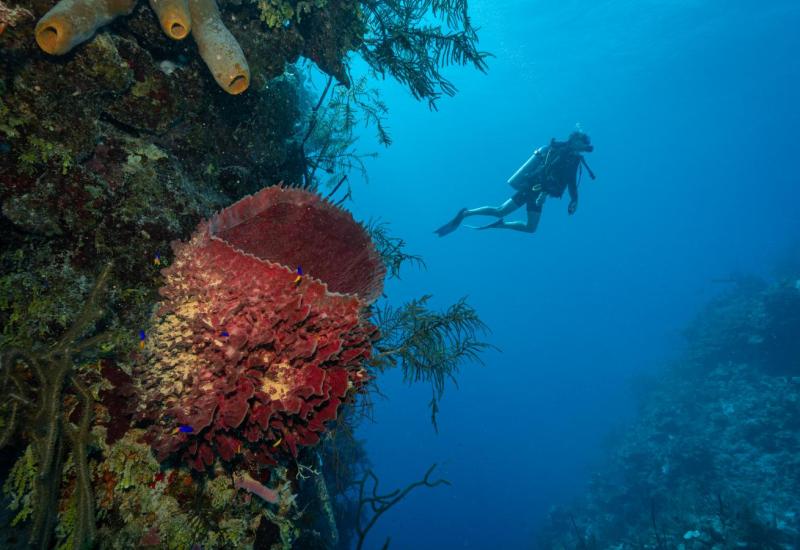Cayman Sister Islands
 |
June 2001
By the Readers and Editors of RSD
| |Related Product
|---
Reef Fish Identification|
| The Unofficial Guide to the World's Best Diving Vacations |
||
|---|
|  |
|
| |
The Sister Islands, Cayman Brac and Little Cayman, are to our Readers' Choice Top 100 awards what Venus and Serena Williams are to the world of women's professional tennis--a winning pair.
Based on the voting of thousands of RSD readers, the twin islands collectively walked away from our 8th annual Top 100 awards with more golden statues than any other destination on the planet. Thanks to world-class wall diving, a unique wreck dive, a healthy marine environment, great vis, top-notch dive operators and laid-back resorts with great food, the quiet islands--located just nine miles apart--collectively earned the award for Best Overall Caribbean Destination. Not bad for a pair of islands that doesn't see as many divers in a year as Grand Cayman sees in a month.
Read on to find out what makes the islands so appealing to our readers, and be sure to count up all the Readers' Choice Award icons. They're your at-a-glance guide to why divers have a serious crush on the Sister Islands. They're also your chance to win a limited edition Stahlsac mesh dive bag.
 |
Wall to Wall Diving
RSD readers also rate the Sister Islands as the Caribbean's Best Wall Diving, thanks to a unique location in the central Caribbean. All three of the Cayman Islands, in fact, are the exposed, flattened tips of a subsea mountain range known as the Cayman Ridge. Rising from the deepest point (25,200 feet) of the Caribbean Sea, the islands break the surface just high enough to provide a convenient place to change tanks, then fall away sharp, clean and vertical.
The most stunning example is Little Cayman's Bloody Bay Wall, where the diving starts in a beginner-friendly 20 feet of water and drops off seemingly forever. Readers rated Bloody Bay Wall and Jackson Point as one of the Top Five Caribbean Dive Sites. While there's no need to go deeper than 80 to 100 feet for the best reef and fish life, advanced divers are always curious about what lies beyond, and the deep possibilities helped the Sister Islands pull in the Best Advanced Caribbean Diving award.
The rocky substrate of the islands is ideal habitat for coral reefs, and generations of reef-building hard corals have decorated the drop-off and walls with tunnels, chimneys and pinnacles that are covered with an array of orange elephant ear and tube sponges. The isolation of the Sister Islands' reefs and the absence of massive developments have meant less stress on the coral system, and the still-pristine nature of the diving here earned the Healthiest Caribbean Marine Environment and Best Caribbean Fish Life awards. Photographers take note; your macro lenses will come in handy here. Tucked into the reef are an abundance of cleaning stations, hermit crabs and nudibranchs to fill your frame. In fact, the islands also earned a slot in the Top Five Best Caribbean Destinations for Macro Life list.
A Clear Vision
Another benefit to being centrally located in the deepest part of the sea--amazing visibility. The Sister Islands boast a consistent average visibility of 100 feet and the third spot on the list of the Top Five Best Caribbean Destinations for Visibility.
A single dive site on Cayman Brac, the upright wreck of the M/V Capt. Keith Tibbetts, has also done wonders for the islands. As the only diveable Russian warship in the western hemisphere, the wreck has attracted a lot of attention to The Brac, including praise from readers as a Top Five Best Caribbean Wreck Diving Destination. The Tibbetts also made the list of Top 10 Favorite Caribbean Dive Sites.
 |
Share and Share Alike
No matter which island you're staying on, chances are that during a week's stay you'll make a day trip to the other island. Weather permitting, and for an additional fee, your dive operator will make the nine-mile crossing. Divers on Little Cayman head to The Brac to dive the Tibbetts while divers on Cayman Brac cross over to see Bloody Bay Wall. Both islands are also the epitome of "laid-back," with a handful of small, dive-centered resorts and intimate dive lodges featuring great food, onsite dive shops and plenty of peace and quiet. And here's a number for you: A stunning 95.7 percent of divers in our survey said they would return to the Sister Islands.
Add it all up, and it's easy to see why the Sister Islands earned a spot on the Top Five Most Popular Destinations list for the entire planet.
Dive In: Sister Islands
Getting There: Cayman Airways, the national carrier, offers direct flights to Grand Cayman from U.S. gateways and continuing jet service from Grand Cayman to Cayman Brac. American, Continental, Delta, Northwest and U.S. Airways also fly to Grand Cayman. Island Air offers daily commuter flights to Cayman Brac and Little Cayman.
Weather: Expect daytime highs in the 70s in winter, and in the mid- to high 80s in the summer.
Water Conditions: Temperatures drop into the high 70s in winter and peak in the low 80s in summer. Visibility varies from 80 to 200 feet, with peak water clarity occurring during the calm summer months.
Electricity: 110 volts, 60 cycles, the same as the United States.
Documents: Passports are recommended, though U.S. and Canadian citizens get by with a birth certificate and photo ID.
Money Matters: The Cayman dollar (CI$) is worth more than the U.S. dollar. The fixed rate is CI$1 to US$1.25. U.S. dollars and major credit cards are widely accepted.
Telephone: The Cayman Islands area code is 345.
Food and Water: Food and tap water are safe.
Just In Case: Grand Cayman has a recompression chamber staffed 24 hours a day. Telephone: 949-2989.
For More Information: Call the Cayman Islands Department of Tourism (800) 346-3313.
June 2001
By the Readers and Editors of RSD
| [Reef Fish Identification](http://www.amazon.com/exec/obidos/ASIN/1878348302/rodalesscubadivi/002-7482067-0655244?dev-t=D68HUNXKLHS4J%26camp=2025%26link_code=xm2)| | [The Unofficial Guide to the World's Best Diving Vacations](http://www.amazon.com/exec/obidos/ASIN/0764562207/rodalesscubadivi/002-7482067-0655244?dev-t=D68HUNXKLHS4J%26camp=2025%26link_code=xm2) | |
The Sister Islands, Cayman Brac and Little Cayman, are to our Readers' Choice Top 100 awards what Venus and Serena Williams are to the world of women's professional tennis--a winning pair.
Based on the voting of thousands of RSD readers, the twin islands collectively walked away from our 8th annual Top 100 awards with more golden statues than any other destination on the planet. Thanks to world-class wall diving, a unique wreck dive, a healthy marine environment, great vis, top-notch dive operators and laid-back resorts with great food, the quiet islands--located just nine miles apart--collectively earned the award for Best Overall Caribbean Destination. Not bad for a pair of islands that doesn't see as many divers in a year as Grand Cayman sees in a month.
Read on to find out what makes the islands so appealing to our readers, and be sure to count up all the Readers' Choice Award icons. They're your at-a-glance guide to why divers have a serious crush on the Sister Islands. They're also your chance to win a limited edition Stahlsac mesh dive bag.
Wall to Wall Diving
RSD readers also rate the Sister Islands as the Caribbean's Best Wall Diving, thanks to a unique location in the central Caribbean. All three of the Cayman Islands, in fact, are the exposed, flattened tips of a subsea mountain range known as the Cayman Ridge. Rising from the deepest point (25,200 feet) of the Caribbean Sea, the islands break the surface just high enough to provide a convenient place to change tanks, then fall away sharp, clean and vertical.
The most stunning example is Little Cayman's Bloody Bay Wall, where the diving starts in a beginner-friendly 20 feet of water and drops off seemingly forever. Readers rated Bloody Bay Wall and Jackson Point as one of the Top Five Caribbean Dive Sites. While there's no need to go deeper than 80 to 100 feet for the best reef and fish life, advanced divers are always curious about what lies beyond, and the deep possibilities helped the Sister Islands pull in the Best Advanced Caribbean Diving award.
The rocky substrate of the islands is ideal habitat for coral reefs, and generations of reef-building hard corals have decorated the drop-off and walls with tunnels, chimneys and pinnacles that are covered with an array of orange elephant ear and tube sponges. The isolation of the Sister Islands' reefs and the absence of massive developments have meant less stress on the coral system, and the still-pristine nature of the diving here earned the Healthiest Caribbean Marine Environment and Best Caribbean Fish Life awards. Photographers take note; your macro lenses will come in handy here. Tucked into the reef are an abundance of cleaning stations, hermit crabs and nudibranchs to fill your frame. In fact, the islands also earned a slot in the Top Five Best Caribbean Destinations for Macro Life list.
A Clear Vision
Another benefit to being centrally located in the deepest part of the sea--amazing visibility. The Sister Islands boast a consistent average visibility of 100 feet and the third spot on the list of the Top Five Best Caribbean Destinations for Visibility.
A single dive site on Cayman Brac, the upright wreck of the M/V Capt. Keith Tibbetts, has also done wonders for the islands. As the only diveable Russian warship in the western hemisphere, the wreck has attracted a lot of attention to The Brac, including praise from readers as a Top Five Best Caribbean Wreck Diving Destination. The Tibbetts also made the list of Top 10 Favorite Caribbean Dive Sites.
Share and Share Alike
No matter which island you're staying on, chances are that during a week's stay you'll make a day trip to the other island. Weather permitting, and for an additional fee, your dive operator will make the nine-mile crossing. Divers on Little Cayman head to The Brac to dive the Tibbetts while divers on Cayman Brac cross over to see Bloody Bay Wall. Both islands are also the epitome of "laid-back," with a handful of small, dive-centered resorts and intimate dive lodges featuring great food, onsite dive shops and plenty of peace and quiet. And here's a number for you: A stunning 95.7 percent of divers in our survey said they would return to the Sister Islands.
Add it all up, and it's easy to see why the Sister Islands earned a spot on the Top Five Most Popular Destinations list for the entire planet.
Dive In: Sister Islands
Getting There: Cayman Airways, the national carrier, offers direct flights to Grand Cayman from U.S. gateways and continuing jet service from Grand Cayman to Cayman Brac. American, Continental, Delta, Northwest and U.S. Airways also fly to Grand Cayman. Island Air offers daily commuter flights to Cayman Brac and Little Cayman.
Weather: Expect daytime highs in the 70s in winter, and in the mid- to high 80s in the summer.
Water Conditions: Temperatures drop into the high 70s in winter and peak in the low 80s in summer. Visibility varies from 80 to 200 feet, with peak water clarity occurring during the calm summer months.
Electricity: 110 volts, 60 cycles, the same as the United States.
Documents: Passports are recommended, though U.S. and Canadian citizens get by with a birth certificate and photo ID.
Money Matters: The Cayman dollar (CI$) is worth more than the U.S. dollar. The fixed rate is CI$1 to US$1.25. U.S. dollars and major credit cards are widely accepted.
Telephone: The Cayman Islands area code is 345.
Food and Water: Food and tap water are safe.
Just In Case: Grand Cayman has a recompression chamber staffed 24 hours a day. Telephone: 949-2989.
For More Information: Call the Cayman Islands Department of Tourism (800) 346-3313.










